Etiquette and Formal Behavior
Are Manners Important?
Posted By: Paul - Tue Jan 16, 2024 -
Comments (0)
Category: Etiquette and Formal Behavior, PSA’s, 1950s
The New Century Standard Letter-Writer
You might have fun browsing through this book on correspondence.
The section on Love Letters is lots of fun.
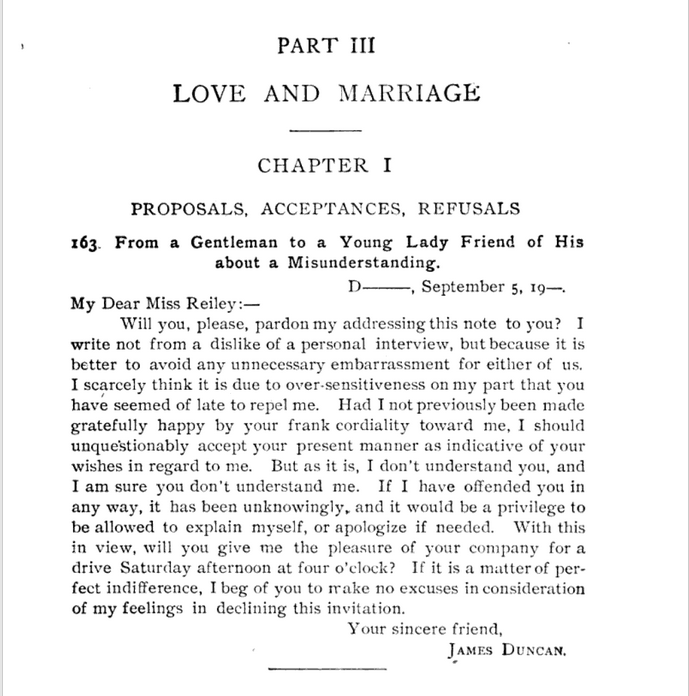
Also, for some reason there are four pages on Etiquette, reproduced below. I would hope every lady and gentleman among us would follow these enlightened precepts.
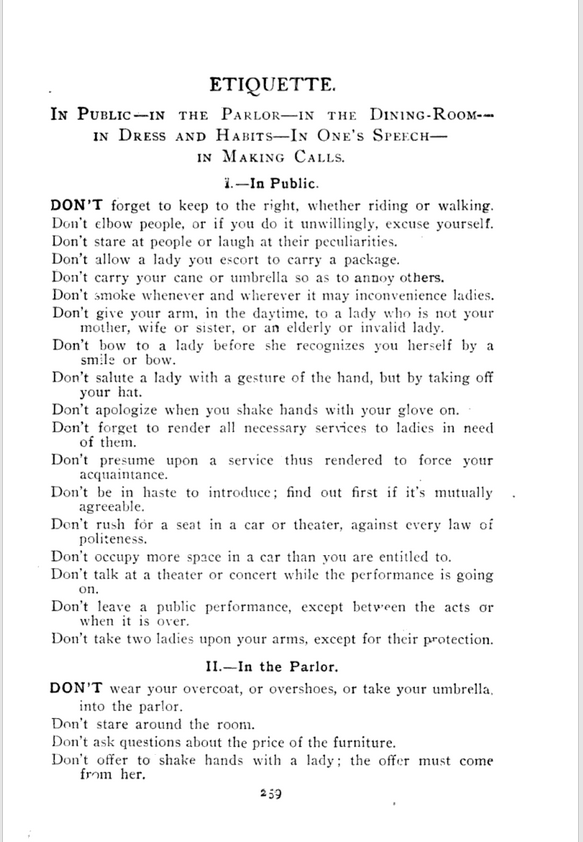
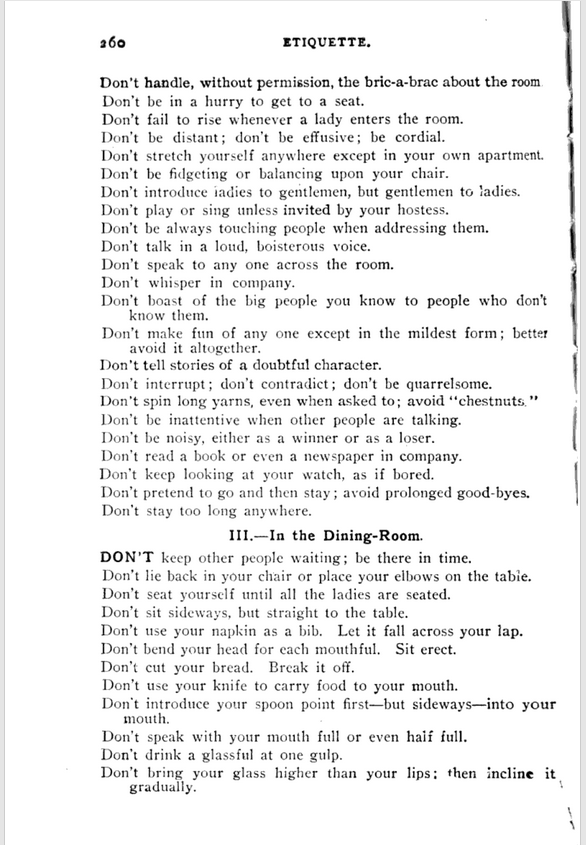
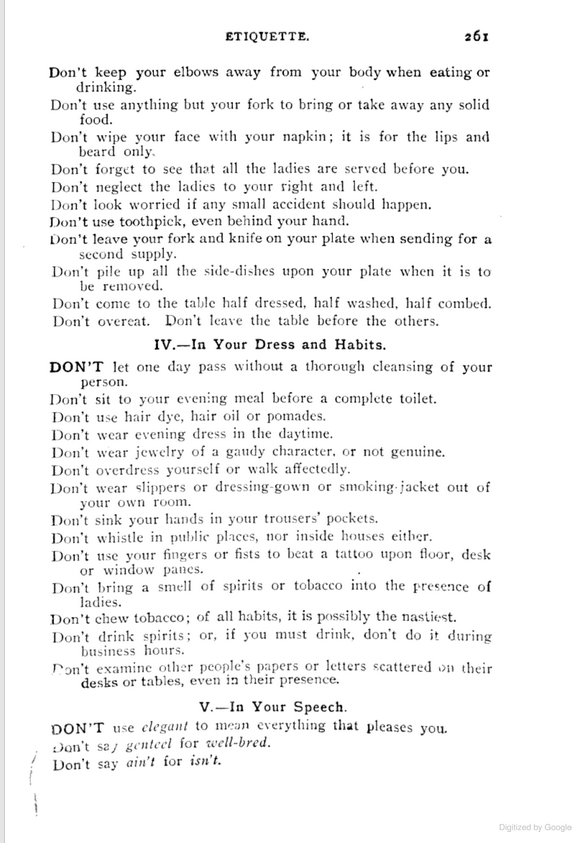
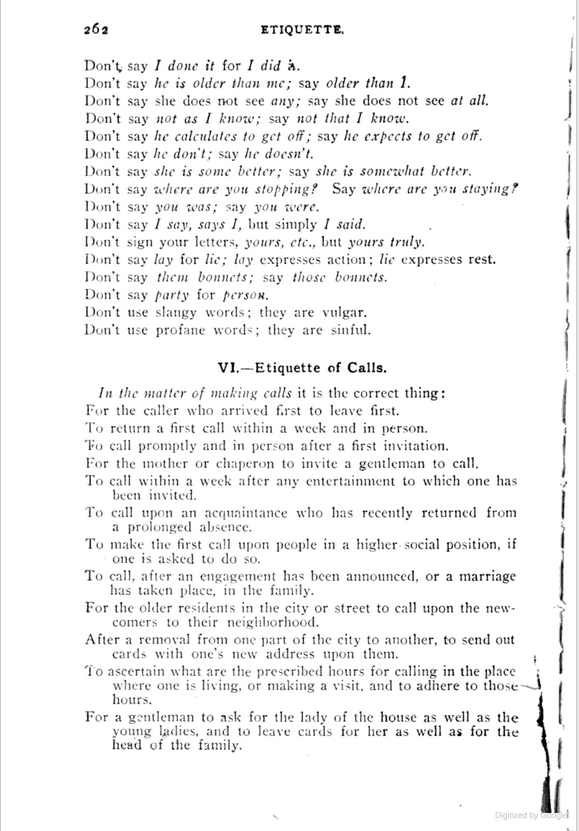
Posted By: Paul - Sun May 01, 2022 -
Comments (5)
Category: Etiquette and Formal Behavior, Correspondence, Telegrams, Letters, and Other Written Communications, Books, 1900s
How to Succeed With Brunettes
Posted By: Paul - Sun Jan 31, 2021 -
Comments (0)
Category: Annoying Things, Antisocial Activities, Customs, Emotions, Etiquette and Formal Behavior, PSA’s, 1960s, Men, Women
A Manual of Gesture
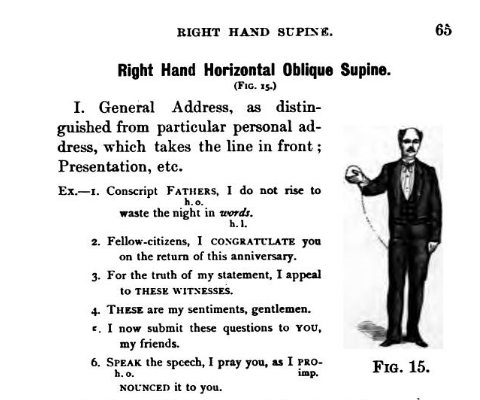
All the things to do with your person while performing in public.
Full text here.
Posted By: Paul - Sat Jun 22, 2019 -
Comments (1)
Category: Body, Etiquette and Formal Behavior, Experts and Authority Figures, Nineteenth Century
Lady Fishbourne’s Complete Guide to Better Table Manners
Lady Fishbourne's Complete Guide to Better Table Manners, Janet Perlman, provided by the National Film Board of Canada
Posted By: Paul - Tue Mar 05, 2019 -
Comments (1)
Category: Antisocial Activities, Culture and Civilization, Customs, Etiquette and Formal Behavior, 1970s
Flag-Burning Etiquette
According to the Veterans of Foreign Wars, when American flags get old, they should be burned instead of being thrown in the trash:1. The flag should be folded in its customary manner.
2. It is important that the fire be fairly large and of sufficient intensity to ensure complete burning of the flag.
3. Place the flag on the fire.
4. The individual(s) can come to attention, salute the flag, recite the Pledge of Allegiance and have a brief period of silent reflection.
5. After the flag is completely consumed, the fire should then be safely extinguished and the ashes buried.
6. Please make sure you are conforming to local/state fire codes or ordinances.

Posted By: Alex - Wed Jul 04, 2018 -
Comments (5)
Category: Etiquette and Formal Behavior, Flags
Handshake Etiquette
From Amy Vanderbilt's complete book of etiquette: a guide to gracious living (1957).A handshake is as much a part of personality as the way we walk, and although we may modify and improve a poor handshake if someone calls our attention to it, it will usually be just like us, assured or timid, warm or cool.
Bad handshakes include the bone crusher—the grip that makes the other person, especially a woman wearing rings, wince. Or a limp, damp handshake that seems to say, "I am not really happy to meet you at all!" Or it may be the kind of straight-arm shake that seems to hold the other person off, or the octopus grip that draws you inexorably toward the shaker, who never seems to want to let go. Then there's the pump handle, or country bumpkin shake, and the very Continental style—reserved for women—which, though not a hand kiss exactly, is cozy and overlong, ending in an intimate little squeeze.
The good handshake is elbow level, firm and brief. A man does not offer to shake hands with a woman unless she makes the move first. Outdoors, it is no longer necessary for him to keep her waiting awkwardly while he removes his glove, nor need he apologize for taking her hand with his glove on. Whether he is shaking the hand of a man or a woman, the shaker must look the person he is greeting firmly in the eye and, at least, look pleasant, if he doesn't actually smile.
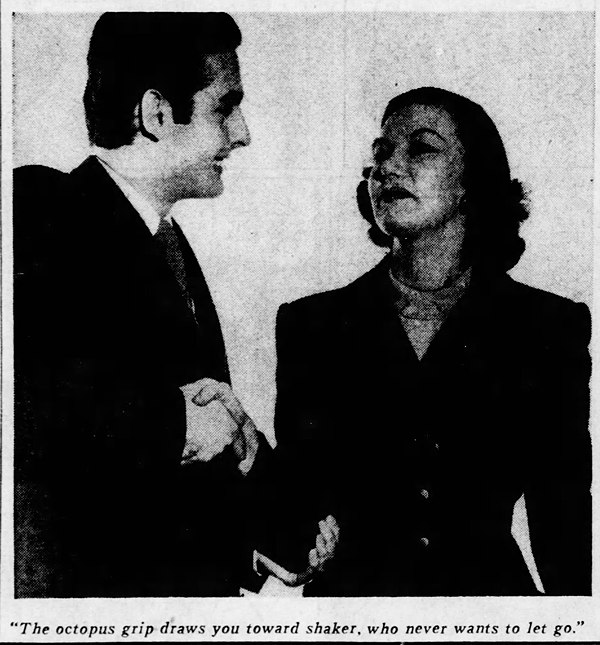
The Octopus Grip
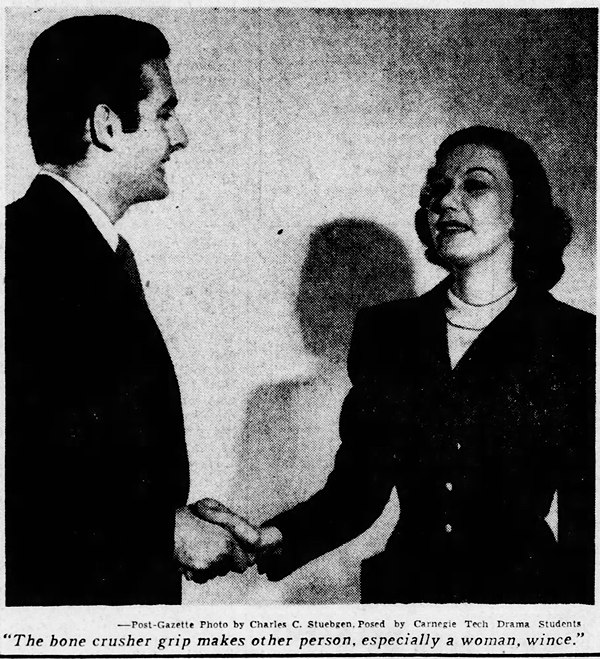
The Bone-Crusher
Pittsburgh Post-Gazette - Nov 21, 1952
Posted By: Alex - Wed Feb 28, 2018 -
Comments (3)
Category: Etiquette and Formal Behavior, 1950s
A Community of Respectful Pals

Dear WU-vies:
Alex and I have just taken a step which I do not believe we have ever needed to take before in the long history of WEIRD UNIVERSE. We deleted someone's comment because it was nasty, rude, hostile and generally boorish. (And may I also say that the suffering longtime member of the community, the commenter to whom the insults were addressed, reacted with restraint, dignity, calm and a noble nature.)
Let me take this unfortunate occasion to remind everyone that WU has always been a landmark of collegiality and friendliness and acceptance, albeit happily flavored with irony, black humor and appreciation for the world's incredible stupidity. Especially in comparison to much of the internet, WU remains a happy place. Let's try to keep it that way.
Thanks, as always, for your attention, support and understanding.
Posted By: Paul - Thu Feb 22, 2018 -
Comments (7)
Category: Beauty, Ugliness and Other Aesthetic Issues, Etiquette and Formal Behavior, Weird Universe, Comments
A Date With Your Family
No one, even at the time, thought of incest allusions?
Posted By: Paul - Sat Oct 07, 2017 -
Comments (3)
Category: Etiquette and Formal Behavior, Family, PSA’s, 1950s
Elevator Proxemics

Proxemics was a term coined by anthropologist Edward Hall to describe the study of "man's use of space as a specialized elaboration of culture."
Elevator proxemics, by extension, is the study of the use of space in elevators. Or put another way, how people behave in elevators.
The most widely cited expert on this subject is the psychologist Layne Longfellow. On his website, he describes how he became the media's go-to guy for questions about elevator behavior:
"Ralph, I know nothing about it and have never given it a second thought."
"I know, but you have a prestigious position as a psychologist and you're funny, so make something up."
I leaned back in my swivel chair, tossed my feet up on my desk, gazed unfixedly into the trees outside my window, and said some things that I thought were, in fact, funny - but also true. Ralph published the article, and then my phone REALLY began to ring - I had entered the world's media archives as an expert on elevator behavior.
Below are a few nuggets of wisdom I've been able to glean about the science of elevator behavior, gathered from a handful of articles, mostly referencing Longfellow. Although a few other researchers have also been roped into becoming instant experts on the subject.
- Studies of elevator body placement show a standard pattern. Normally the first person on grabs the corner by the buttons or a corner in the rear. The next passenger takes a catercorner position. Then the remaining corners are seized, and next the mid-rear-wall and the center of the car. Then packing becomes indiscriminate.
- "When the sixth person gets on you can watch the shuffle start," says Longfellow. "People don't quite know what to do with the sixth person. Then another set of rules comes into play governing body contact."
- In an uncrowded elevator, men stand with hands folded in front or women will hold their purses in front. That's called the Fig Leaf Position. Longfellow says, "As it gets more crowded you can see hands unfold and come down to the sides, because if you have your hands folded in front of you in a really crowded elevator, there's no telling where your knuckles might end up. So out of respect for the privacy of other people you unfold them and put them at your side."
- High-status individuals are given more space. For instance, if the president of the company gets on, he gets more space.
- Men leave more space between themselves and other men than women do with other women.
- People tend to put more space between themselves and others wearing bright colors because, says psychologist Robert Sommer, "it's too much stimulation."
- According to Ralph Keyes, "The self-confident, it turns out, never get on first. Instead, they wait affably with underlings for the cab, then wave everyone ahead into the car like a hen mothering chicks."
- Passengers avoid eye contact because, explains Longfellow, "eye contact, especially in American culture, is the root to intimacy."
- "The ultimate egregious faux pas a person can commit in an elevator is to face the back," says Longfellow. "Everybody allocates as much space as possible to the lunatic who's facing the wrong way. If you'll do something so outrageous as to stand backwards and look at them, God knows what else you would do."
- Everyone looks at the numbers. The most common explanation for this is that it allows everyone to avoid eye contact, and it gives people "the appearance of having something to do." But anthropologist Harvey Sarles argues that the real reason to watch the numbers "is to enhance peripheral vision and allow you to keep an eye out for any quick, dangerous movements around you. Then if someone is going to jump you, you can make an adjustment."
Longfellow eventually distilled his knowledge into a handy 7-point guide to How To Behave In An Elevator:
|
Sources: LA Times - Aug 20, 1982; New York magazine - Nov 21, 1977. Image source: intro to soc.
Posted By: Alex - Tue Aug 30, 2016 -
Comments (5)
Category: Etiquette and Formal Behavior

| Who We Are |
|---|
| Alex Boese Alex is the creator and curator of the Museum of Hoaxes. He's also the author of various weird, non-fiction, science-themed books such as Elephants on Acid and Psychedelic Apes. Paul Di Filippo Paul has been paid to put weird ideas into fictional form for over thirty years, in his career as a noted science fiction writer. He has recently begun blogging on many curious topics with three fellow writers at The Inferior 4+1. Contact Us |




